
The Camden markets are a number of adjoining large retail markets, often collectively referred to as Camden Market or Camden Lock, located in the historic former Pickfords stables, in Camden Town, London. It is situated north of the Hampstead Road Lock of the Regent's Canal. Famed for their cosmopolitan image, products sold on the stalls include crafts, clothing, bric-a-brac, and fast food. It is the fourth-most popular visitor attraction in London, attracting approximately 250,000 people each week.

The Shambles is a historic street in York, England, featuring preserved medieval buildings, some dating back as far as the 14th century. The street is narrow, with many timber-framed buildings with jettied floors that overhang the street by several feet. It was once known as The Great Flesh Shambles, probably from the Anglo-Saxon Fleshammels, the word for the shelves that butchers used to display their meat. In 1885, thirty-one butchers' shops were located along the street, but none remain today.
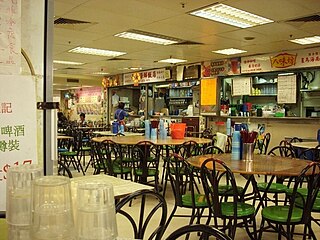
A hawker centre or cooked food centre is an open-air complex commonly found in Hong Kong, Malaysia and Singapore. They were built to provide a more sanitary alternative to mobile hawker carts and contain many stalls that sell different varieties of affordable meals. Dedicated tables and chairs are usually provided for diners.

Dai pai dong is a type of open-air food stall. The term originates from Hong Kong but has been adopted outside Hong Kong as well. The official government name for these establishments is "cooked-food stalls". The more common name, dai pai dong, literally means "big licence stall" in Cantonese, referring to the stalls' license plates, which are larger than those of other licensed street vendors.
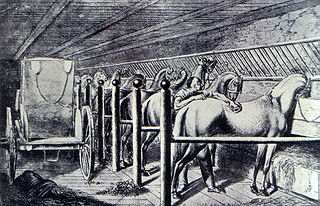
An animal stall is an enclosure housing one or a few animals. Stalls for animals can often be found wherever animals are kept: a horse stable is often a purpose-built and permanent structure. A farmer's barn may be subdivided into animal stalls or pens for cows and other livestock.
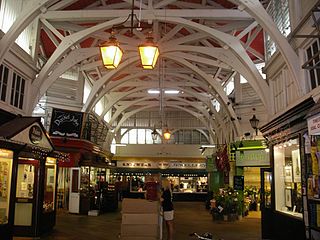
The Covered Market is a historic market with permanent stalls and shops in a large covered structure in central Oxford, England.
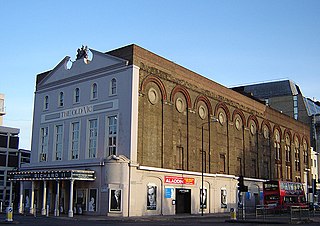
The Cut is a street in London which runs between Waterloo Road in Lambeth and Blackfriars Road in Southwark, approximately parallel to the South Eastern Railway. The Old Vic theatre is at the western (Lambeth) end, and the more experimental Young Vic theatre halfway along on the other side. Lewisham Southwark College is sited on the south side of the Cut and at the eastern (Southwark) end is Southwark Underground station. Waterloo and Waterloo East stations are also nearby.

Taiwanese night markets are night markets in Taiwan that operate in urban or suburban areas between sunset and sunrise. A few, such as Huaxi Street Tourist Night Market, use purpose-built marketplaces, but most occupy either sidewalks or even entire streets that carry vehicle and pedestrian traffic by day. Some night markets in smaller side streets and alleys feature retractable roofs. Most night markets operate daily and feature a mixture of individual stalls selling clothing, consumer goods, xiaochi, and specialty drinks. The atmosphere is usually crowded and noisy with hawkers shouting and fast-paced music playing over loudspeakers. Taiwanese night markets have evolved over the years from small, local gatherings to noisy streets lined with vendors, who must adhere to regulations placed on their activities by the Taiwanese government.

The Lunar New Year Fair, also known as the flower market, is a type of fair held annually a few days before Lunar New Year in Chinese New Year markets in China. These fairs are primarily practiced by the Cantonese, and spread with Cantonese immigration.

Kirkgate Market is a market complex on Vicar Lane in the city centre of Leeds, West Yorkshire, England. It is the largest covered market in Europe and a Grade I listed building. There are currently 800 stalls which attract over 100,000 visitors a week.

Exmouth Market is a semi-pedestrianised street in Clerkenwell in the London Borough of Islington, and the location of an outdoor street market of 32 stalls.

Queen's Market, also known as Queen's Road Market, and Green Street Market, is a historic street market in the London Borough of Newham. It lies adjacent to Green Street and Upton Park tube station.

Surrey Street Market is a street market located in Surrey Street, Croydon, south London. Records of a market on the site date back to the 13th century.

Newport Market is a traditional Victorian indoor market in Newport, South Wales. It is a Grade II-Listed building in the city centre, owned and operated by Newport City Council. The main structure, completed in 1889, is an early example of a large-span cast iron-frame building featuring a glazed barrel roof. The market re-opened in March 2022 as a multi-purpose food, retail and office space following a £5–6 million pound renovation.

Norwich Market is an outdoor market consisting of around 200 stalls in central Norwich, England. Founded in the latter part of the 11th century to supply Norman merchants and settlers moving to the area following the Norman conquest of England, it replaced an earlier market a short distance away. It has been in operation on the present site for over 900 years.

Salamanca Market is a street market in Salamanca Place, Hobart, Tasmania, Australia.

A pissoir is a French invention, common in Europe, that provides a urinal in public space with a lightweight structure. The availability of pissoirs aims to reduce urination onto buildings, sidewalks, or streets. They can be freestanding and without screening, with partial screening, or fully enclosed.
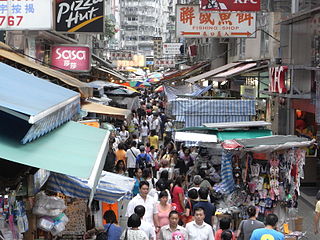
Hawkers in Hong Kong are vendors of street food and inexpensive goods. They are found in urban areas and new towns alike, although certain districts such as Mong Kok, Sham Shui Po, and Kwun Tong are known for high concentrations of hawkers.



















